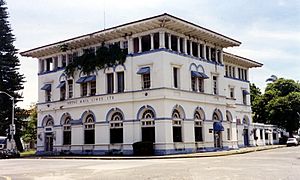Cristóbal, Colón facts for kids
Quick facts for kids
Cristóbal
Corregimiento
|
|
|---|---|
|
County
|
|

Cristóbal's Bldg. 1104
|
|
| Country | |
| Province | Colón |
| District | Colón |
| Area | |
| • Land | 428.5 km2 (165.4 sq mi) |
| Population
(2010)
|
|
| • Total | 49,422 |
| • Density | 115.3/km2 (299/sq mi) |
| Population density calculated based on land area. | |
| Time zone | UTC−5 (EST) |
Cristóbal is a port town in Panama. It is also a corregimiento, which is like a local district or county. Cristóbal is located in the Colón Province, on the Atlantic side of the famous Panama Canal. In 2010, about 49,422 people lived there.
The name Cristóbal Colón is the Spanish way of saying Christopher Columbus. This important explorer is who the town is named after.
Contents
How Cristóbal Began
The area known as "Old Cristóbal" started in the 1850s. The Panama Railroad Company built it. They dug up a large swamp on Manzanillo Island. This was to create their main office and a port for train travelers.
In the 1880s, a French company arrived. They wanted to build a canal across Panama. They found the nearby city of Colón (then called Aspinwall) was very small. Most of Manzanillo Island was still a swamp.
The French used soil from their canal digging. They filled in a coral reef next to the railroad area. This new land became their base. They called it Christophe Colombe. This name was later translated into Spanish as Cristóbal Colón.
In 1904, Panama became independent from Colombia. The United States then bought the French canal project. The US also gained control of the Canal Zone. This included the Panama Railroad's land. So, Cristóbal became part of the Canal Zone.
Life in Cristóbal, Canal Zone
Cristóbal was super important for building the Panama Canal. It was the main entry point. All the building equipment came through here. Most of the workers and their supplies arrived in Cristóbal. The town needed to grow quickly.
By 1906, Cristóbal had over 2,100 people. Almost 500 of them were Americans. Just one year later, the population grew to over 4,000. A quarter of these were Americans.
New homes were built for workers. There were two main groups of workers. "Gold roll" employees were mostly white Americans. "Silver roll" employees were mainly laborers from the West Indies. Many workers lived in temporary housing.
In 1907, the Cristóbal Women's Club started. Other groups like the Masonic and Elks lodges were also active. Stores and community centers were built. The town kept growing north.
In 1913, the Hotel Washington was built. It replaced an older railroad building. Cristóbal residents had many services. These included a post office, police, and fire stations. They also had churches, a yacht club, and a YMCA.
After the Panama Canal opened, large piers were built in Cristóbal. Shipping companies moved into an area called Steamship Row. A new army base, Fort De Lesseps, was built nearby. This meant new homes were needed for US employees.
So, a new part of town was planned. It was called New Cristóbal. It was built by filling in more swamp areas. This also helped the city of Colón grow. New schools were built, including Cristobal High School in 1933. During this time, Cristóbal's port employed almost 2,000 people.
Changes Over Time
The mid-1950s brought big changes to Cristóbal. Many people moved to new areas like Margarita and Coco Solo. The Canal Zone's borders on Manzanillo Island also changed. This happened because of a treaty in 1955. Cristóbal's population dropped a lot.
Starting in 1957, some land in Cristóbal was given to Panama. This included all of New Cristóbal. Cristobal High School moved to Coco Solo. The Hotel Washington also came under Panama's control. Many properties that the Panama Railroad had owned for over 100 years were transferred.
By the early 1960s, Cristóbal was mostly for businesses. Not many people lived there. There were some protests against the US in Cristóbal. New Cristóbal became a popular place for people from Colón. But other areas of Colón and former Panama Railroad lands declined in the 1970s and 1980s.
In 1979, the Torrijos-Carter Panama Canal Treaties began. The Canal Zone was ended. The US started transferring control of the Canal to Panama. Many areas in Cristóbal were among the first to be transferred. The Panama Railroad stopped running in the early 1980s.
Cristóbal Today
Today, Cristóbal is part of the city of Colón. However, "Cristóbal" is also the name of the district. This district covers the Atlantic side of what used to be the Canal Zone.
What to See
You can still see the old buildings from Steamship Row. These buildings are important for their history. Other famous places in Cristóbal are well-kept. These include the Hotel Washington and Christ Church by the Sea. St. Mary's Academy's Church is also a notable sight.
The Port
Cristóbal's port is very busy today. It is managed by private companies. It also competes with other ports built nearby.
See also
 In Spanish: Cristóbal (Panamá) para niños
In Spanish: Cristóbal (Panamá) para niños





